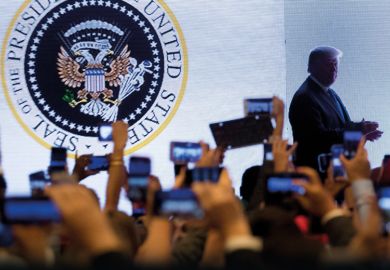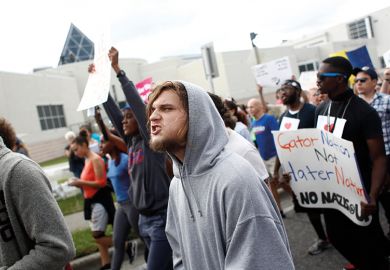The Trump administration has eased its threats of broad financial penalties for colleges that violate free-speech protections, although not far enough to avoid a showdown with institutions still sensing a regulatory overreach.
President Trump, angered by the hostile reception given to right-wing speakers on some US college campuses, has for months issued open-ended threats to force more welcoming environments by tying compliance to billions of dollars in federal postsecondary spending.
But in its formal proposal for a regulatory change to impose the idea, the administration has scaled back the potential penalties and offered a more neutral trigger mechanism. The scheme would only impose penalties on colleges that lose a court case over a First Amendment issue − and then limit the potential for supplemental punishment to Education Department grant funds.
The approach, the department said in a statement, reflects the administration’s belief that “state and federal courts remain the best arbiters of alleged violations of First Amendment freedoms”.
That is still too much for US university leaders. Associations representing nearly all of US higher education wrote to education secretary Betsy DeVos, saying that they already take seriously the need to ensure free-speech rights on their campuses and that the proposed regulation would only be counterproductive.
Conditioning federal grant money on court judgments involving unrelated First Amendment disputes could, among other problems, encourage excessive and frivolous complaints, the American Council on Education (ACE) and 25 other higher education associations told Ms DeVos.
The Trump plan also would leave institutions unsure where to set their policies, given the unavoidable differences between courts and their judges on how to interpret specific cases, the ACE-led grouping said.
And while the administration’s proposed penalty for a court defeat would omit the biggest chunks of federal spending on higher education − student aid and research grant awards − there’s no guarantee that other federal agencies would not extend the model, the groups said.
The repercussions could be even worse at private institutions, the higher education groups said. Private colleges can legally set their own free-speech rules, and the Trump proposal would apply its penalties in cases where the institutions are found to have violated their own campus policies.
Private colleges could be expected to respond by weakening their voluntary free-speech rules, “a result that runs completely counter to the stated goal of the proposed rule”, the groups said.
The administration’s proposed regulation runs to more than 200 pages, much of them concerned with matters of constitutional rights for religious organisations that don’t necessarily involve higher education.
An outside group that advocates for free-speech rights on college campuses, the Foundation for Individual Rights in Education (Fire), said it shares many of the concerns raised by the ACE and the other university groups.
“This kind of approach might affect litigation around free speech in unpredictable ways,” said Joe Cohn, the legislative and policy director at Fire.
But, Mr Cohn added, the language of the proposed regulation seems to allow for interpretations − hopefully clarified during the drafting process − that should ease some of the worst fears, such as including the possibility of specific limitations on the amounts of federal money at risk in a losing legal battle.
In general, Fire has credited US universities with making long-term improvements in their free-speech practices. In its latest annual report, the organisation said the number of US institutions that maintained at least one severely restrictive policy has declined for 12 straight years. That number, however, still represents more than 24 per cent of US colleges, Fire said in the report.
Register to continue
Why register?
- Registration is free and only takes a moment
- Once registered, you can read 3 articles a month
- Sign up for our newsletter
Subscribe
Or subscribe for unlimited access to:
- Unlimited access to news, views, insights & reviews
- Digital editions
- Digital access to THE’s university and college rankings analysis
Already registered or a current subscriber?







